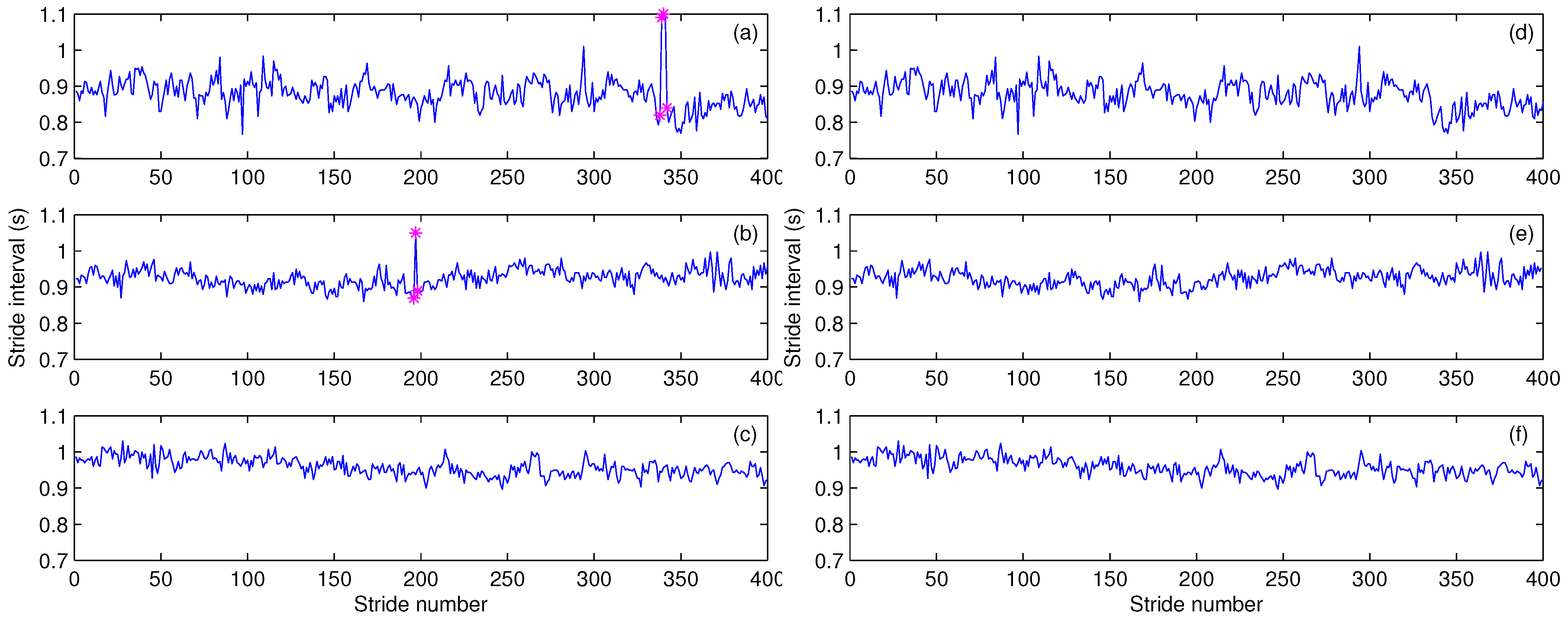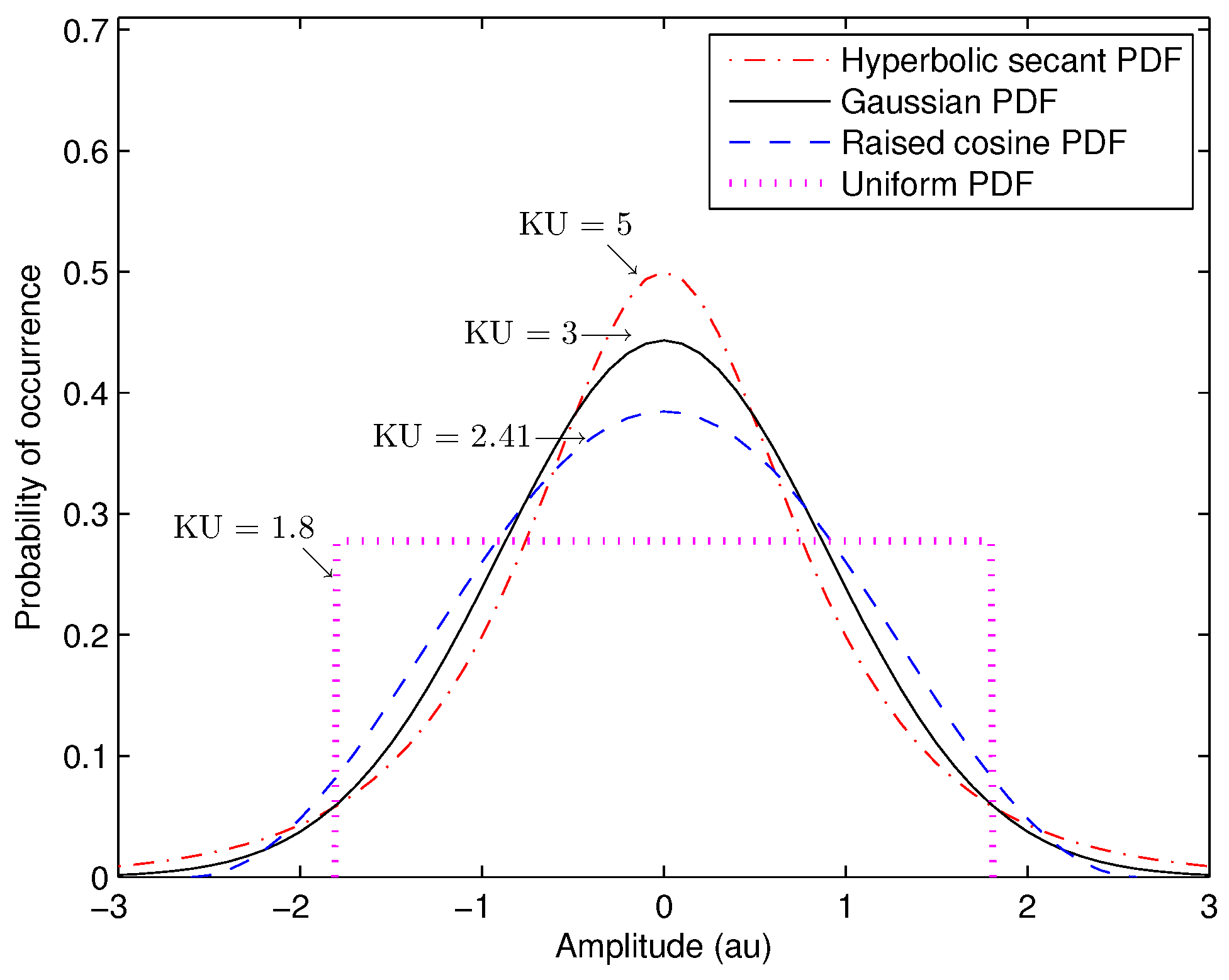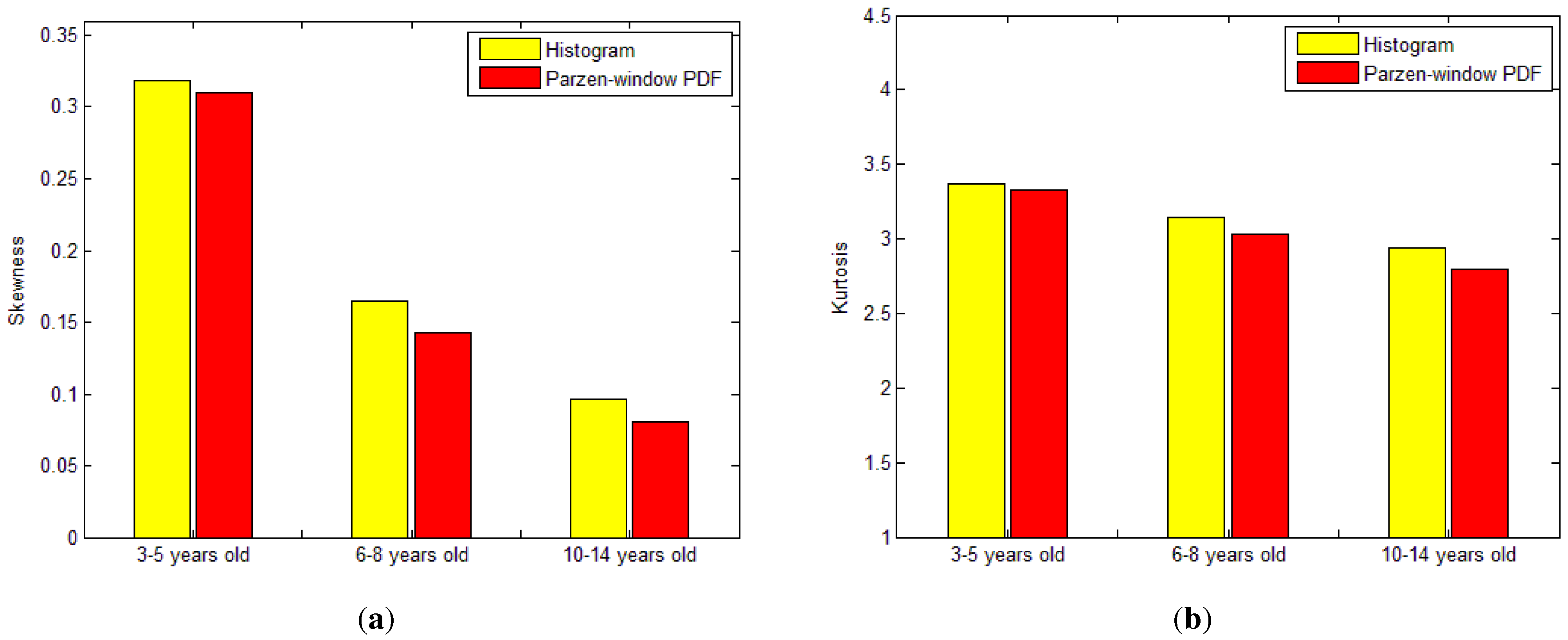3.1. Signal Preprocessing
Because two legs have to modulate the acceleration or deceleration behavior at the beginning or ending of walking, the walking velocity and other gait parameters are somewhat different from those in the course of walking at normal pace. In order to minimize the start-up or ending effects of walking posture, the samples of stride interval recorded in the first 60 s (1 min) and the last 5 s were excluded, which was the same as implemented in the previous study of Hausdorff
et al. [
3].
A median filter [
17] was applied to detect the outliers that were 3 standard deviations (SDs) in amplitude greater than the median value in the time series of stride interval. According to the well-known “three-sigma rule” [
18], about 99.7% of the normally distributed probability values lies within 3-SD distance from the mean, which implies the outliers only occur with a very low probability (about 0.3%). Since some outliers possessed very large values and could affect the computing of the mean over the entire time series, we used the median value instead of the mean of the corresponding time series.
The time series examples of original and outlier-processed stride interval of the children in three different age groups are illustrated in
Figure 1. Since the start-up effects have been eliminated, the first stride in each time series was made from the second minute in the 8 min monitoring. In
Figure 1a and b, the outliers detected, along with one stride before or after the outliers, are marked with asterisks in the original time series. These stride interval samples, which were considered to be associated with the pauses during the gait monitoring, were removed before the gait analysis. It is noted that the child aged 129 months regulated his strides with little variation, and there is no outlier found in the time series of stride interval in
Figure 1c.
Figure 1.
Original time series of stride interval of the children (a) aged 45 months (in the group aged 3–5 years); (b) aged 80 months (in the group aged 6–8 years); and (c) aged 129 months (in the group aged 10–14 years), respectively. Outliers detected, along with one stride before or after the outliers, are marked with asterisks; Subfigures (d)–(f) plot the corresponding outlier-free time series of stride interval. The first strides in (a)–(f) start after the start-up 60 s (1 min).
Figure 1.
Original time series of stride interval of the children (a) aged 45 months (in the group aged 3–5 years); (b) aged 80 months (in the group aged 6–8 years); and (c) aged 129 months (in the group aged 10–14 years), respectively. Outliers detected, along with one stride before or after the outliers, are marked with asterisks; Subfigures (d)–(f) plot the corresponding outlier-free time series of stride interval. The first strides in (a)–(f) start after the start-up 60 s (1 min).
From
Figure 1d, e and f, it is clear that these representative time series exhibit distinct characteristics. The degree of stride fluctuations is highest in the youngest child (aged 3–5 years), whereas the stride-to-stride variability of the other two children (aged 6–8 years and 10–14 years) becomes much smaller, as reported by Hausdorff
et al. [
3] that the stride fluctuations measured by coefficient of variation and SD of detrended time series are significant different between any two age groups (
). Such differences are more visible in
Figure 2. It can be observed that the spread of the PDF of the child aged 45 months is much wider than those of the older children aged 80 and 129 months, respectively. In addition, the mean value of the stride interval of the children aged 129 months is about 0.96 s, which is larger in amplitude than those of the younger children (0.87 and 0.93 s for aged 45 and 80 months, respectively).
Figure 2.
Histograms and Parzen-window probability density functions (PDFs) estimated for the stride interval time series of the children (a) aged 45 months (in the group aged 3–5 years); (b) aged 80 months (in the group aged 6–8 years); and (c) aged 129 months (in the group aged 10–14 years), respectively.
Figure 2.
Histograms and Parzen-window probability density functions (PDFs) estimated for the stride interval time series of the children (a) aged 45 months (in the group aged 3–5 years); (b) aged 80 months (in the group aged 6–8 years); and (c) aged 129 months (in the group aged 10–14 years), respectively.
3.2. Probability Density Function (PDF) Estimation
In order to derive the statistical parameters related to the gait maturation in children, we first computed the histogram as a reference of PDF, for each outlier-free time series of stride interval. The histogram of stride interval can be established with
B bins, which helped calculate the probability of occurrence with
B containers of equal length in the amplitude range of stride interval. According to Scott’s choice [
19], the optimal bin number
B that helps minimize the mean squared error between the estimated histogram and the Gaussian density function can be obtained as
where
s and
n represent the SD and the number of samples in the stride interval time series, respectively; the highest and lowest values of stride interval
g are denoted as
and
, respectively; and the operator
rounds the number of bins toward the nearest integer greater than or equal to it.
Then we applied the Parzen-window method [
20] to estimate the PDF of stride interval from the outlier-free time series, for each subject. Given a
M-length time series of stride interval,
,
, the estimated PDF
can be expressed as [
14,
21,
22]
where
is a window function that integrates to unity. In the present study, we used the popular Gaussian window function to estimate the Parzen-window PDF of stride interval,
i.e.,
where
represents the spread parameter that determines the width of a Gaussian window, the center of which is located at
[
21]. In order to determine the optimal spread parameter, the Parzen-window PDF was arranged with the same resolution as the histogram,
i.e., the estimated probability density,
,
, was also represented with
B bins. Then the optimal spread parameter can be obtained by minimizing the mean-squared error (MSE) between the Parzen-window PDF,
, and the histogram,
,
i.e.,
. By searching the value of spread parameter that varied over the range from 0.001 to 0.1, with an increment of 0.001, the optimal value of
was set to be 0.01 in accordance with the MSE minimization criterion.
Figure 2 shows the histograms and the PDFs estimated for the representative subjects of the three age groups in
Figure 1. Gaussian PDFs (
dashed curves) are fit with the Gaussian distributions, the mean and variance parameters of which are equal to those of the corresponding histograms. It is worth noting that all the PDFs are unimodal, but not exactly overlap the reference Gaussian distributions. The stride interval PDF of the youngest child possesses the largest spread area, in comparison with the PDFs of the other two children. In addition, the center location of stride interval PDF seems to move toward a larger value with the increase of age. Such probability distributions motivate us to compute the statistical parameters for detailed comparisons.
3.3. Statistical Parameters
Four statistical parameters,
i.e., averaged stride interval (ASI), variation of stride interval (VSI), skewness (SK), and kurtosis (KU), were computed with the Parzen-window PDF estimated [
14]. The ASI and VSI represent the mean and SD values of stride interval,
i.e.,
and
Statistical measures (ASI and VSI) of stride interval for the children in the three age groups are shown in
Figure 3. The Student’s
t-test [
23] was also performed to test whether or not the values of the ASI and VSI are significantly different (significant level:
) between any two bars for the corresponding age groups.
Figure 3.
Bar graphics of (a) averaged stride interval (ASI) and (b) variation stride interval (VSI) computed from the Parzen-window probability density functions (PDFs) of the children in the groups aged 3–5 years, 6–8 years, and 10–14 years, respectively. Vertical lines on the tops of the bars denote the standard deviation (SD) values. The values (mean ± SD) of the bars for the children of 3–5 years old (ASI: s, VSI: s), of 6–8 years old (ASI: s, VSI: s), and of 10–14 years old (ASI: s, VSI: s).
Figure 3.
Bar graphics of (a) averaged stride interval (ASI) and (b) variation stride interval (VSI) computed from the Parzen-window probability density functions (PDFs) of the children in the groups aged 3–5 years, 6–8 years, and 10–14 years, respectively. Vertical lines on the tops of the bars denote the standard deviation (SD) values. The values (mean ± SD) of the bars for the children of 3–5 years old (ASI: s, VSI: s), of 6–8 years old (ASI: s, VSI: s), and of 10–14 years old (ASI: s, VSI: s).
From
Figure 3, we may observe that both the ASI and VSI are age-dependent: the ASI increases with age, whereas the VSI decreases when the children grow up. The ASI value for the 6- to 8-year-old age group is 0.056 s higher (
) than that for the 3- to 5-year-old age group, and the value is increased by 0.099 s (
) comparing the 10- to 14-year-old children with that for the 6- to 8-year-old children. On the other hand, the VSI value is decreased by 0.023 s (
) in the children aged from 3 years to 8 years, and then continues to be decreased by 0.008 s (
) until the children are 14 years old. Such results suggest that the children are more and more skilled to modulate large strides during the course of musculoskeletal growth, and the ability to control stable strides is significantly improved in the children aged 3–8 years. It can therefore be inferred that the locomotor control system in children aged 3–8 years is still rapidly developing, and will reach maturity until they are 14 years old, when their gait patterns become very close to those of healthy adults [
3].
The SK and KU are two parameters that usually measure the asymmetry and “peakedness” characteristics of a PDF [
24,
25]. The SK and KU can be calculated from the PDF moments as
and
where
represents the
jth central moment of the PDF [
26,
27], defined as
Figure 4 illustrates three typical SK values for a unimodal PDF: if the PDF is symmetric or balanced, e.g., the Gaussian distribution, the skewness is zero; if the mass of the PDF is concentrated on the left of the mean, the PDF is right-skewed,
i.e., the skewness is positive (SK > 0); in contrast, if the mass of the PDF concentrates on the right of the mean, the PDF is then left-skewed,
i.e., the skewness is negative (SK < 0).
Figure 4.
Illustration of the probability density functions (PDFs) with three types of skewness (SK): right-skewed PDF, dash-dot curve, SK ; symmetric PDF, solid curve, SK (in particular Gaussian distributions); left-skewed PDF, dashed curve, SK . Dot line represents a central axis up to the mean of the symmetric PDF. au: arbitrary units.
Figure 4.
Illustration of the probability density functions (PDFs) with three types of skewness (SK): right-skewed PDF, dash-dot curve, SK ; symmetric PDF, solid curve, SK (in particular Gaussian distributions); left-skewed PDF, dashed curve, SK . Dot line represents a central axis up to the mean of the symmetric PDF. au: arbitrary units.
Figure 5 shows four well-known PDFs with different KU values: the sharper the peak of distribution, the larger the KU becomes. The top of uniform distribution is flat, and its KU is smallest (KU = 1.8); the Gaussian distribution possesses a KU value of 3.0, which is usually considered as the benchmark for KU comparison; the peak of the raised cosine PDF is more rounded than the Gaussian distribution, so that the KU value is 2.41; the hyperbolic secant PDF [
28] has the sharpest peak and the largest KU value (KU = 5) among the four distributions.
The SK and KU results of the histogram and Parzen-window PDF are provided in
Figure 6 and
Table 1. It can be observed that the SK values for the children aged 3–14 years are positive and age-dependent, and the SK decreases (histogram: from 0.32 to 0.1; Parzen-window PDF: from 0.31 to 0.08) when the children grow up. The right-skewed PDF indicates that the mass of the distribution is located on the left side of the figure, which implies that more than a half of the stride interval samples are lower in amplitude than the mean of the PDF (see the representative examples in
Figure 1). In addition, it is worth noting from
Figure 6a that the SK decreases rapidly when the children are 3–8 years old, and continues to decrease at a slower rate until the children are 14 years old. Such results confirm our inference about the development process of the locomotor control system in young children described above.
Figure 5.
Illustration of four typical probability density functions (PDFs) that possess different kurtosis (KU) values: uniform distribution, dot curve, KU ; raised cosine distribution, dashed curve, KU ; Gaussian distribution, solid curve, KU ; hyperbolic secant distribution, dash-dot curve, KU . au: arbitrary units.
Figure 5.
Illustration of four typical probability density functions (PDFs) that possess different kurtosis (KU) values: uniform distribution, dot curve, KU ; raised cosine distribution, dashed curve, KU ; Gaussian distribution, solid curve, KU ; hyperbolic secant distribution, dash-dot curve, KU . au: arbitrary units.
Figure 6.
Bar graphics of the mean values of (
a) skewness (SK) and (
b) kurtosis (KU) computed from the histograms and the Parzen-window probability density functions (PDFs) of the 3- to 5-year-old, 6- to 8-year-old, and 10- to 14-year-old age groups, respectively. Statistics of the skewness and the kurtosis for the three age groups are listed in
Table 1.
Figure 6.
Bar graphics of the mean values of (
a) skewness (SK) and (
b) kurtosis (KU) computed from the histograms and the Parzen-window probability density functions (PDFs) of the 3- to 5-year-old, 6- to 8-year-old, and 10- to 14-year-old age groups, respectively. Statistics of the skewness and the kurtosis for the three age groups are listed in
Table 1.
Table 1.
Statistical parameters computed from the histograms and the Parzen-window probability density functions (PDFs) of 50 children subjects (equal number of boys and girls). Values are mean ± standard deviation (SD).
Table 1.
Statistical parameters computed from the histograms and the Parzen-window probability density functions (PDFs) of 50 children subjects (equal number of boys and girls). Values are mean ± standard deviation (SD).
| Statistical parameters | 3–5 years old | 6–8 years old | 10–14 years old |
|---|
| Skewness (SK) | Histogram | | | |
| Parzen-window PDF | | | |
| Kurtosis (KU) | Histogram | | | |
| Parzen-window PDF | | | |
From
Figure 6b, it can be observed that the KU values of the PDFs are higher than 3.0 (the value of Gaussian PDF in
Figure 5) and lower than 5.0 (the value of hyperbolic secant PDF in
Figure 5) when the children are 3–5 years old, are very close to 3.0 when the children are 6–8 years old, and are between 2.41 (the value of raised cosine PDF in
Figure 5) and 3.0 when the children are 9–14 years old. Such results indicate that the PDF curves become smoother and smoother during the course of musculoskeletal growth in children, and the distributions of the stride-to-stride interval in children are not heavily concentrated on the means of the corresponding PDFs. It may be inferred that the musculoskeletal growth enables the children to better control the strides at different speeds.










